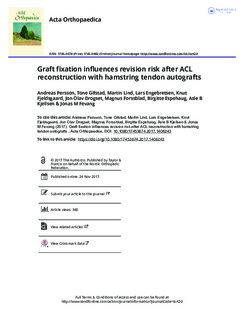| dc.contributor.author | Persson, Andreas | |
| dc.contributor.author | Gifstad, Tone | |
| dc.contributor.author | Lind, Martin | |
| dc.contributor.author | Engebretsen, Lars | |
| dc.contributor.author | Fjeldsgaard, Knut | |
| dc.contributor.author | Drogset, Jon Olav | |
| dc.contributor.author | Forssblad, Magnus | |
| dc.contributor.author | Espehaug, Birgitte | |
| dc.contributor.author | Kjellsen, Asle | |
| dc.contributor.author | Fevang, Jonas Meling | |
| dc.date.accessioned | 2018-03-23T18:53:18Z | |
| dc.date.available | 2018-03-23T18:53:18Z | |
| dc.date.created | 2018-01-09T14:51:09Z | |
| dc.date.issued | 2017 | |
| dc.identifier.citation | Acta Orthopaedica. 2017, under utgivelse. | |
| dc.identifier.issn | 1745-3674 | |
| dc.identifier.uri | http://hdl.handle.net/11250/2492011 | |
| dc.description | This is an Open Access article distributed under the terms of the Creative Commons Attribution-Non-Commercial License (https://creativecommons.org/licenses/by-nc/3.0) | |
| dc.description.abstract | Background and purpose — A large number of fixation methods of hamstring tendon autograft (HT) are available for anterior cruciate ligament reconstruction (ACLR). Some studies report an association between fixation method and the risk of revision ACLR. We compared the risk of revision of various femoral and tibial fixation methods used for HT in Scandinavia 2004–2011. Materials and methods — A register-based study of 38,666 patients undergoing primary ACLRs with HT, with 1,042 revision ACLRs. The overall median follow-up time was 2.8 (0–8) years. Fixation devices used in a small number of patients were grouped according to design and the point of fixation. Results — The most common fixation methods were Endobutton (36%) and Rigidfix (31%) in the femur; and interference screw (48%) and Intrafix (34%) in the tibia. In a multivariable Cox regression model, the transfemoral fixations Rigidfix and Transfix had a lower risk of revision (HR 0.7 [95% CI 0.6–0.8] and 0.7 [CI 0.6–0.9] respectively) compared with Endobutton. In the tibia the retro interference screw had a higher risk of revision (HR 1.9 [CI 1.3–2.9]) compared with an interference screw. Interpretation — The choice of graft fixation influences the risk of revision after primary ACLR with hamstring tendon autograft. | |
| dc.language.iso | eng | |
| dc.subject | anterior cruciate ligament surgery | |
| dc.subject | autografts | |
| dc.subject | bone screws (orthopedic) | |
| dc.subject | fracture fixation | |
| dc.subject | hamstring muscle | |
| dc.subject | Scandinavia | |
| dc.subject | femur surgery | |
| dc.subject | tibia surgery | |
| dc.subject | confidence intervals | |
| dc.subject | regression analysis | |
| dc.subject | reoperation | |
| dc.subject | propotional hazards models | |
| dc.subject | descriptive statistics | |
| dc.subject | medical implant registries | |
| dc.title | Graft fixation influences revision risk after ACL reconstruction with hamstring tendon autografts : A study of 38,666 patients from the Scandinavian knee ligament registries 2004–2011 | |
| dc.type | Peer reviewed | |
| dc.type | Journal article | |
| dc.description.version | publishedVersion | |
| dc.rights.holder | © 2017 The Author(s). | |
| dc.source.pagenumber | 7 | |
| dc.source.journal | Acta Orthopaedica | |
| dc.identifier.doi | 10.1080/17453674.2017.1406243 | |
| dc.identifier.cristin | 1539006 | |
| dc.description.localcode | Seksjon for idrettsmedisinske fag / Department of Sport Medicine | |
| cristin.unitcode | 150,34,0,0 | |
| cristin.unitname | Seksjon for idrettsmedisinske fag | |
| cristin.ispublished | true | |
| cristin.fulltext | original | |
| cristin.qualitycode | 1 | |
